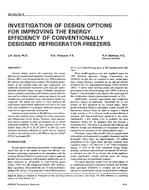Description
Several design options for improving the energy efficiency of conventionally designed domestic refrigerator/freezers (RFs) were incorporated into two 1990 production RF cabinets and refrigeration systems. The baseline performance of the original and unit components was exhaustively documented to provide a firm basis for experimentally measured energy savings. A detailed refrigerator system computer model that could simulate cycling behaviour was used to evaluate the daily energy use impacts for each modification, and modelled versus experimental results are compared. The model was shown to track measured RF performance improvement sufficiently well that it was used with some confidence to investigate additional options that could not be experimentally investigated. Substantial improvements in RF efficiency were demonstrated with relatively minor changes in system components and refrigeration system design. However, each improvement exacts a penalty in terms of increased cost or system complexity/reliability. For RF sizes typically sold in the USA (510 – 620 l) more elaborate alternative refrigeration cycles may be required to achieve the programme goal (1.00 kWh/day for a 570l top-mount RF.
KEYWORDS: Refrigeration, efficiency, energy consumption, designing, thermodynamic cyclic, computer programs, calculating.
Citation: Symposium, ASHRAE Trans. 1994, Vol.100, Part 1,
Product Details
- Published:
- 1994
- File Size:
- 1 file , 1.2 MB
- Product Code(s):
- D-17968




